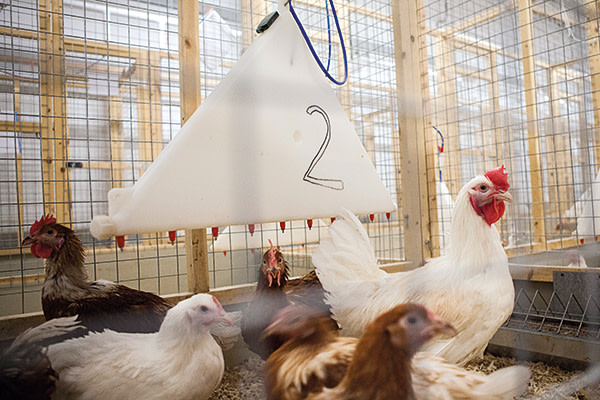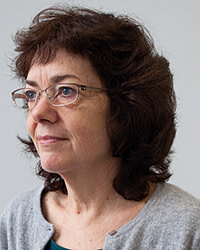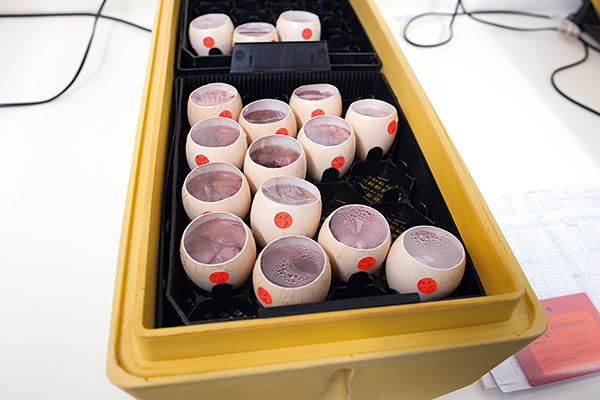Are these the chickens of the future?
Simply sign up to the Life & Arts myFT Digest -- delivered directly to your inbox.
The eggs sit in a heated yellow box, the tops of their shells sliced off and replaced with cling film. Inside, translucent red bodies poke and press, alien-like, against the film. These are some of the rarest chicken embryos in the world, their DNA altered by scientists at Scotland’s Roslin Institute, an international centre of research on animal genetics. “They’ll hatch tomorrow,” says Professor Helen Sang, a wavy-haired 61-year-old geneticist who has spent much of her career perfecting techniques for the genetic modification of chickens.
Famous for creating Dolly the sheep, the first cloned mammal, in 1996, Roslin is at the forefront of research into chicken genetics, and houses about 1,700 genetically bespoke birds. Once the chicks hatch, they will spend their lives in a large shed on the institute’s sprawling rural campus just outside Edinburgh, where they will be observed and tested to see how they differ from their natural peers. Adult birds are placed in spacious wooden pens; one contains hens whose eggs include a new protein that is being tested as a potential treatment for liver damage. Other GM chicks at Roslin have had their immune cells tagged with a fluorescent protein so that, after death, scientists can see where invading microbes have clustered. Still other birds contain an extra gene that interrupts the transmission of avian flu. While none of these “superchickens” has been developed to be eaten — they represent “proof of concept”, as Sang put it to a 2014 British parliamentary committee — she believes their successors might one day make it to the dinner table. But do we really need GM chickens? And will consumers ever want to eat them?
In Britain, 95 per cent of people eat chicken, usually twice a week or more. Its mild flavour makes it a blank canvas for recipes ranging from nuggets to vindaloo. At least 50 billion birds worldwide are reared each year for their meat; another five billion are kept as laying hens, according to the International Egg Commission, which represents the egg industry. But feeding our fondness for chicken and eggs is a challenge as population levels rise and higher incomes in developing economies mean more people can afford to put meat on the table.

Poultry, which includes turkeys, ducks and geese, accounts for about 35 per cent of all meat eaten globally, and is soon predicted to overtake pork, currently at 36 per cent. Chicken is the cheapest, most accessible meat, low in fat and with a relatively modest carbon footprint; there are also few cultural or religious taboos surrounding its consumption. In China, chicken feet are particularly in demand.
The stated aim of the Roslin Institute, which is part of Edinburgh University, is to “tackle some of the most pressing issues in animal health and welfare, their implications for human health and for the role of animals in the food chain”. On that basis it receives funding worth £34m a year, most of which comes from the Biotechnology and Biological Sciences Research Council, a government agency that bankrolls public bioscience research. Public bodies, including the Department for Food and Rural Affairs and the Food Standards Agency, also put money in the Roslin pot, and just under a 10th of its funding comes from charities such as the Wellcome Trust, the biomedical charity. Two per cent of the institute’s annual budget comes from multinationals including Pfizer, and from companies such as Cobb-Vantress, a poultry breeding and genetics business owned by US conglomerate Tyson Foods. The industry as a whole would like to breed chickens more efficiently while emitting less methane and using fewer antibiotics. It also wants to produce high-quality, disease-free eggs, while satisfying consumer demand for better animal welfare.

The long-term plan of Sang and her team is to develop a healthier genetic blueprint for a bird whose physiology has suffered over decades of selective breeding. By creating a more resilient chicken, they hope to help producers meet the rise in global demand without sacrificing animal wellbeing. “Society has to respond to the demand of an increasing, and increasingly wealthy, population,” says Sang. “Our ultimate goal is to improve the chicken, and to improve the lot of the chicken.”
. . .

Today’s commercially bred chickens look far bulkier than did their puny forebears from a century ago — and vastly different to red junglefowl, the wild bird from which they are thought to be descended. After the second world war, consumers craved cheap protein. Breeders selected birds for meatiness without always getting, or preserving, the genes for correspondingly strong bones. Today, there are too many broilers (chickens bred for meat) propped up by brittle skeletons and serviced by overworked hearts. The animal welfare charity Peta says the average breast of an eight-week-old chicken is seven times heavier than it was 25 years ago.
“I don’t think people understand how successful poultry-breeding genetics has been in changing the characteristics of chickens since the second world war,” says Sang. “But those initial goals were not particularly good for the welfare of the animal.”
All those changes were wrought by selective breeding, which means basically picking out animals with the desired characteristics and mating them. Now companies such as Aviagen, Hy-Line and Cobb-Vantress — which sell trademarked pedigree breeds (such as Aviagen’s Ross 308) that are used to produce millions of supermarket birds — have realised that science can replace pedigree information with genome information. According to the British Poultry Council, selective breeding programmes can already target 40 characteristics that fall under genetic influence, from bone health and the oxygen-carrying capacity of blood (a proxy for heart health) to food efficiency and growth rate.
Some traits are controlled by multiple genes rather than by a single one; to identify which genes are responsible for which traits, companies and researchers must sequence the genes of thousands of birds. Each bird is then assigned a “breeding value”. As a result, the modern science of poultry genetics is likely to revive interest in old or rare breeds, which may constitute reservoirs of useful gene variants.
Dr John Hickey, a 34-year-old quantitative geneticist at Roslin who grew up in Ireland on a sheep and cattle farm, specialises in this field. “My task is to sequence the genomes of 289,000 birds, for which we already have detailed pedigree information. That’s exciting because it allows us to unravel the biology of traits much more precisely.” Hickey, who has been at Roslin for three years and whose CV features a stint working with plant breeders in Mexico, says science has always helped us to fulfil our carnivorous aspirations. “With the chicken genetics of the 1950s, every tonne of feed produced 330kg of chicken meat. Today it produces 580kg. Without that progress, we would need twice the agricultural land to produce the meat we have today.”

The industry now wants to push that efficiency further. Individual chickens process food slightly differently. Geneticists are particularly interested in selectively breeding those that can thrive on lower amounts of feed. Rising world grain prices have also prompted research into birds that can stay healthy even when given lower-quality feed, such as dried distiller’s grains with solubles, a nutrient-rich byproduct of the fermentation process used in brewing. Currently, Europe tends to feed its chickens on wheat while the US uses maize. Scientists argue that these high-quality grains could feed people instead.
Some academics, though, believe that raising meat production to feed the world is misguided. “It doesn’t make sense, from the perspective of either human health or sustainability, to increase meat production to meet rising demand,” says Lynn Frewer, professor of food and society at Newcastle University. “An alternative strategy might be to encourage people to adopt diets that contain proteins from legumes and fungi, which take a fraction of the resources required to produce meat. I’m not arguing for a vegetarian world but we need to consider lots of options and not a single response to food security with respect to protein.”
. . .

Avian biologist Dr Ian Dunn, 57, is a self-confessed bird lover who plans to keep chickens when he retires (a pleasure currently denied to him by Roslin’s biosafety rules). He works in a first-floor Roslin office plastered with pictures of chickens, mainly leghorns and silkies, and, like everyone else I meet here, regards the laboratory birds with affection. A copy of International Hatchery Practice lies on the coffee table. “For every bird you eat there needs to be an egg. People probably don’t think about that,” he says. “You need to have huge hatcheries. The whole industry depends on science.”
Dunn’s brief is to solve problems that beset the egg industry. The two big ones are poor bone health in laying hens, and bacterial infections (antibiotic-resistant E. coli and salmonella can be passed from mother to chick, and thence into breeding lines).
Commercially bred hens lay for up to 300 days of the year, a process that literally requires the shelling out of a lot of calcium (in the wild, hens produce up to 30 eggs annually). This heavy laying schedule renders them prone to osteoporosis, a condition that can only be detected definitively postmortem. That’s obviously too late to ensure that future layers are descended from strong-boned stock. Dunn’s team has identified a genetic marker for good bones, which can be applied when the hen is alive.
The bacterial research focuses on the cuticle, a thin protein layer that covers the outside of the egg. The thicker the cuticle, the greater its resistance to bacteria (the egg is expelled through the cloaca, which is also the exit route for faeces). Dunn, working with colleagues at Roslin and elsewhere, has shown that cuticle formation is partly controlled by genes. This paves the way for selectively breeding chickens able to lay down strong cuticles, which block out pathogens such as salmonella.
There is a third area of interest: weaning birds off antibiotics. “Because of the rise of resistance, the poultry of the future will have to manage without the antibiotics that humans use,” says Dunn. “So we are now looking at the microbiome.” The microbiome is the balance of microbes in a bird’s gut, passed on in the egg. The Roslin team has isolated valuable, microbe-killing chemicals from eggs laid by hens with good microbiomes; enriching chicken feed with these chemicals, called ovodefensins, has resulted in better gut health for the birds (less undigested food also means better feed efficiency).
. . .

Despite working with chickens for decades, Dunn remains fascinated by them. “There are so many interesting aspects to their biology, such as the fact that an egg is produced externally, and the way egg formation is controlled. It’s not a unique biology but it’s helped to make chickens world-dominating.”
That roughly 10,000-year journey from the jungle to world domination is still somewhat mysterious. Wildfowl were probably first domesticated not for meat but for cockfighting and divining the future by examining their entrails. Roman armies are also said to have consulted the birds, raised by priests or “augurs”, before heading into battle: a lusty appetite indicated a probable victory, while a refusal to peck at seed suggested the opposite. The priests quickly learnt to keep their charges hungry.
The ancient Egyptians, meanwhile, are credited with perfecting the art of artificial incubation; eggs were kept at just the right temperature, often in caves, and rotated regularly to avoid malformations in the yolk (which, in a fertilised egg, contains the nucleus that will grow into a chick). Artificial incubation was an important step on the road to domestication — it broke the maternal bond, meaning hens didn’t have to incubate their eggs and could therefore be encouraged to lay more frequently.
. . .

Roslin scientists know there is a distinct lack of consumer appetite for GM products in the food chain and, correspondingly, a lack of commercial interest, even though genetic engineering may be the easiest and quickest way of packing desirable traits into a bespoke über-bird.
Cobb-Vantress, which announced in 2014 that it was putting almost $1m into a three-year research programme at Roslin, says that while it helped fund the institute’s work on developing a bird that would block the spread of avian flu, the company has chosen not to pursue commercialisation of that technology “at this time”.
An alternative to genetic modification is gene-editing, also called genome-editing, which is a revolutionary and much more precise cut-and-paste method of working with DNA. Gene-editing might not be covered by current GM legislation — regulatory discussions are ongoing, and will doubtless run in parallel with continued consumer opposition, especially in Europe, to any genetic tinkering with meat.

John Hickey argues that there is an ethical imperative behind the development of GM chickens. “If chickens could be produced more efficiently, more people could eat them. You could argue we have a moral responsibility to meet that demand — or are we going to deny children in Africa access to animal protein? It is very, very difficult to eat a properly nutritious plant-based diet. In the future, GM food might be the only ethical food to eat.”
Timothy Lang, professor of food policy at City University in London and a former hill farmer in Lancashire, salutes Roslin’s genetic wizardry but insists “the developing world doesn’t need high-tech chickens. While there is a case for meat [in the diet], the issue is how much and how it’s produced. We are overconsuming, distorting our land use, and using 40 to 50 per cent of [the world’s] cereals to feed our animals, which is disgraceful. We should be decelerating the treadmill of meat consumption and production, not spinning the wheels of industrialisation faster.”
In the US, the debate about genetically engineered protein has become pressing. In November 2015, the Food and Drug Administration endorsed genetically modified salmon for human consumption, the first approval for a GM fish or meat product. The AquAdvantage salmon, based on an Atlantic breed, contains a growth-hormone gene taken from the Pacific Chinook salmon plus a gene from a fish called an ocean pout. The modifications mean the salmon grows to market size in 18 months rather than three years. Despite FDA approval, several grocery chains have refused to stock the transgenic fish — and consumer groups want it labelled as GM, something the FDA has not yet insisted upon. The approval process itself took two decades.

GM chickens are also unlikely to migrate from the laboratory to supermarket shelves in the near future, if at all. But modern genetics can still inform breeding methods: knowing the genes of individual birds allows particular specimens to be conventionally crossbred with more speed and precision, a bit like mixing individual paints to achieve a perfect hue.
Helen Sang acknowledges that the public may not yet be ready to see her “superchicks” enter the food chain. “We don’t go out and sell our GM chickens,” she says. “Our job is to show what technologies are useful but, ultimately, the breeders and society have to decide whether they want them.”
Anjana Ahuja is a contributing writer on science for the FT
Photographs: Sophie Gerrard
The ethical concerns over ‘playing God’

It took 41 years to get from the first genetically modified animal (a mouse) to the GM salmon that was approved for human consumption last November. That slow progress reflects not only scientific complexities but widespread moral qualms about genetically modified organisms, writes Julian Baggini.
It is, however, surprisingly difficult to come up with a coherent, strong moral objection to GMOs. As their advocates point out, humans have been altering the DNA of plants and animals by selective breeding for millennia. For nearly a century we have been doing this with plants and crops through a method called mutation breeding, in which organisms are bombarded with radiation to accelerate random mutation. Morally speaking, more recent methods of direct genetic manipulation are not fundamentally different. There is nothing new in “playing God”, it’s just that we’re getting better at it.
The most pertinent moral concerns over GMOs are much more pragmatic: we want to be confident that they are safe for human consumption and environmentally benign. This is a legitimate reason for caution but there is no ethical or scientific reason to set a higher bar here than for, say, new herbal medicines, which is precisely what many do.
There is, however, an ethical — perhaps partly aesthetic — consideration that might also explain our wariness. We worry that expanding humanity’s potential can paradoxically be dehumanising. We fear turning ourselves, animals, the environment and society into little more than efficient machines, so becoming alienated from the natural world. All technology does this to a certain extent, but whenever we extend its reach yet further, it is natural to ask whether this is the point at which such mechanisation goes too far.
Julian Baggini is a philosopher and co-author of the FT’s The Shrink & The Sage column
Photograph of mice: Ingrid Moen, Charlotte Jevne, Jian Wang, Karl-Henning Kalland, Martha Chekenya, Lars A Akslen, Linda Sleire, Per Ø Enger, Rolf K Reed, Anne M Øyan and Linda EB Stuhr
Letter in response to this article:
Vital missing detail / From Daniella Acker
Comments